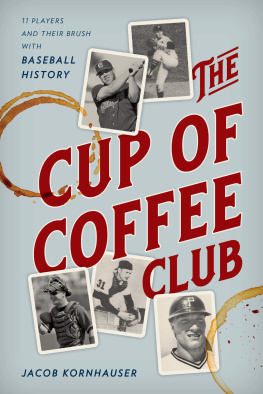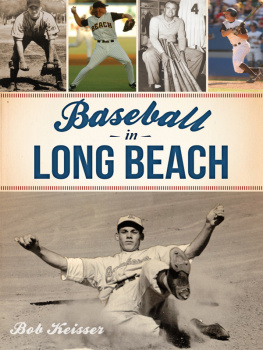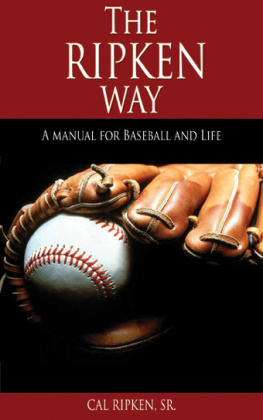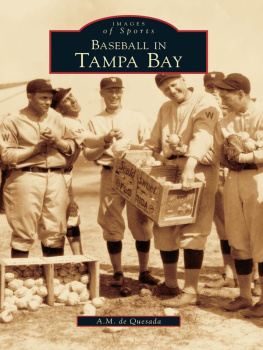Big-League Stories and Strategies for Winning the Mental Gamein Baseball and in Life
Intangibles: Big-League Stories and Strategies for Winning the Mental Gamein Baseball and in Life
All rights reserved. No part of this book may be reproduced or transmitted, in any form or by any means, without written permission of the publisher.
Cover and book design by John Yunker.
Cover photograph by Tyler Wainright.
For my dad, Dr. Alan M. Miller
Team Strategies and Programs
MAP (Mental Aspects of Pitching) Sessions
J im Colborn became the Pirates pitching coach in October of 2005, when Jim Tracy took over as the manager of the team. Tracy and Colborn had coached together back in the 1980s in the Cubs minor league system and had remained close ever since. Colborn was more than just a pitching coach; he was a complex and versatile sage who could provide heady science, comic relief, and competitive fire all in the same breath. He was challenging and intellectual, yet silly and smiling, and he had a way of lulling people to sleep with an absentminded, slow delivery of information that turned sharp and witty just to make sure they were paying attention.
Jim Colborn pitched in the big leagues for twelve seasons, beginning in 1968 with the Chicago Cubs and ending in 1979 with the Kansas City Royals. During those twelve years, he threw 300 innings in a season twice, won twenty games for a bad Milwaukee team, and threw a no-hitter on May 14, 1977, for a good Kansas City team. While his arm survived all those innings, his knees did not. Because hes a big-league pitching coach, many have noticed the pronounced limp sidling Colborn as he jogs painfully to the mound to confer with his pitchers. His bare knees look like a topographical map of the world, with jagged scars, deep indentations, and shelved drop-offs where early orthopedic medical practices took pounds of flesh.
He was also an international scholar who attended Edinburgh on a Rotary scholarship and pitched in the U.K. and the Netherlands while he was in school. His international spirit took him to Japan, in between working with the Cubs and the Seattle Mariners, where he was the pitching coach for the Orix Blue Wave for five years. Colborn became a fluent Japanese speaker, but he typically tucked away his understanding of the language until minutes into an English conversation with a Japanese national, when he would revel in another surprised encounter by starting a sentence in English and then ending it in perfect Japanese. He was a devoted student of the mental game and believed in cultivating the spiritual and intellectual capabilities of each player just as much as he believed in fine-tuning their physical mechanics. His body of work and his actual body showed that he had been battle-tested in the old school. Yet his brain had always been ahead of its time. His coaching reflected this unique combination of old and new, drawing on experiences like having Leo Durocher as his first big-league manager and on friendships with sports psychologists like Gary Mack, who wrote Mind Gym , a popular baseball psychology book.
On the first night of the 2005 Winter Meetings, I got a call from Doug Strange, the assistant GM of the Pirates who had been a great resource for me as I established myself with the major league team. He told me that our new pitching coach, Jim Colborn, was extremely interested in talking to me, and he passed the phone to Colborn so we could get acquainted. Colborn was fascinated that the Pirates had a mental skills coach. He invited me to meet him at his house in Ventura the next week to discuss the mental game and plan for minicamp and spring training.
*
In completing my first year working with the Pirates, Id had a number of individual successes; a solid relationship with Lloyd McClendon, the Pirates manager who had been fired in September; and a strong foothold in developing minor league players, thanks to the support of Brian Graham. However, I was still trying to change the perception that I was there for people who had problems rather than for everyone who wanted to be as good as they possibly could be. While I wasnt awestruck by anyone, I was still cognizant when I was talking with people who had lots of experience in the game. I knew Jim Colborns name very well from his time with the Dodgers. I was blown away that he was so welcoming to me and that he was inviting me to stay at his home and meet his family after I had met him for all of a five-minute phone conversation.
Jim Colborn and his wife, Jenney, lived on one of the tiny strands of beaches on the way from Los Angeles to Santa Barbara. Jim had grown up in Santa Paula, a little citrus town fifteen minutes or so up the Santa Clara River from Ventura. He and Jenney had settled into a beautiful little beach cottage not long after he made it to the big leagues. The cottage had expanded a number of times as the Colborn family expanded in size. Jim and Jenney have three daughters and a son. The Colborn beach house always buzzes with activity as the central meeting place for children, grandchildren, cousins, and lots of friends of the family. A large patio deck sits above the daily surf, which ebbs and flows beneath its pylons each day. After such a long playing and coaching career of travel, apartment rentals in other cities, and time away from each other, it must have been a dream come true for Jim to have been the pitching coach for the Dodgers for those five seasons and to be able to drive himself to his real home each night after games at Dodger Stadium.
I arrived at the Colborn home in the late afternoon on a typical Southern California December day. I brought the Colborns a basket of navel oranges, having stopped in my native Riverside that day, for their kindness in inviting me to their home. Jim, Jenney, and I each ate an orange in their kitchen before we brought beers out to the patio. We shared baseball stories and discussed how we would work together that next season. The sun was setting, and the winter ocean breeze was strong, so Colby went inside and picked out a couple of dugout jackets from his former teams for each of us to wear. Mine was white and had the name of a Japanese team scrawled across it in red. The font looked like the home jerseys that the Cubs wore in the late 1990s, but I didnt recognize the name of the team.
After making some small talk about baseball, Southern California, and the current state of the Pirates, Colby began to explain the program he ran with his pitchers and catchers. He called it MAP, which stood for Mental Aspects of Pitching. Colby would bring his players together to discuss the importance of the mental game, sometimes weaving in his own successes and failures as a big-league pitcher. Then he would set a topic for discussion and ask the pitching staff to pick up the conversation. He would have them discuss focus, confidence, pitching out of jams, pitching in big games, and maintaining intensity level. He found that the more MAP sessions he had, the more the staff would open up with one another. His best pitching staffs trusted one another more and were more cohesive groups because they had shared knowledge and experience together in their MAP sessions.
Colby liked the idea of having both of us prepare and facilitate MAP sessions. I would introduce a Mental Aspect of Pitching, and Colby would provide the real-world experience of having lived that MAP topic as a big leaguer, offering on-field advice for how he handled pressure situations and how he had coached players in similar circumstances. I asked him which topics were most important to him, which techniques he wanted emphasized. The first topic he wanted explained in spring training was focus. He began to explain his understanding of the importance of proper focus for pitchers. He described four different channels on which people focus attention, combining broad, narrow, external, and internal. I tried to listen intently without smiling, but I couldnt hide my happinessColby was explaining TAIS theory.












